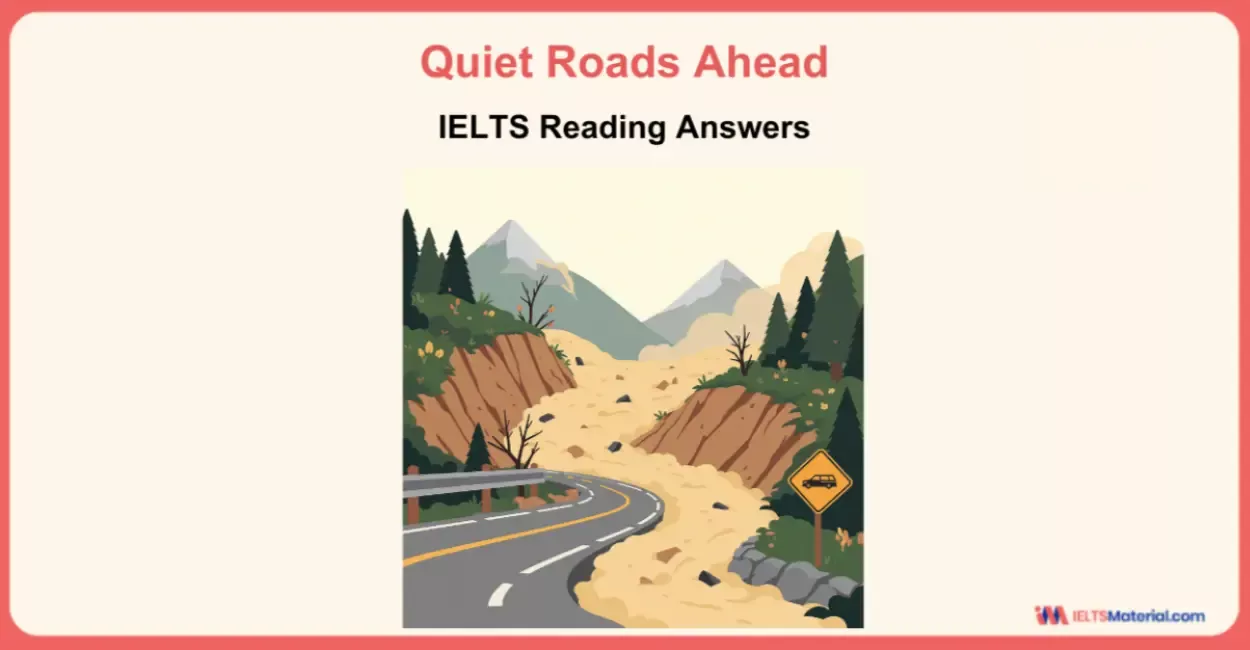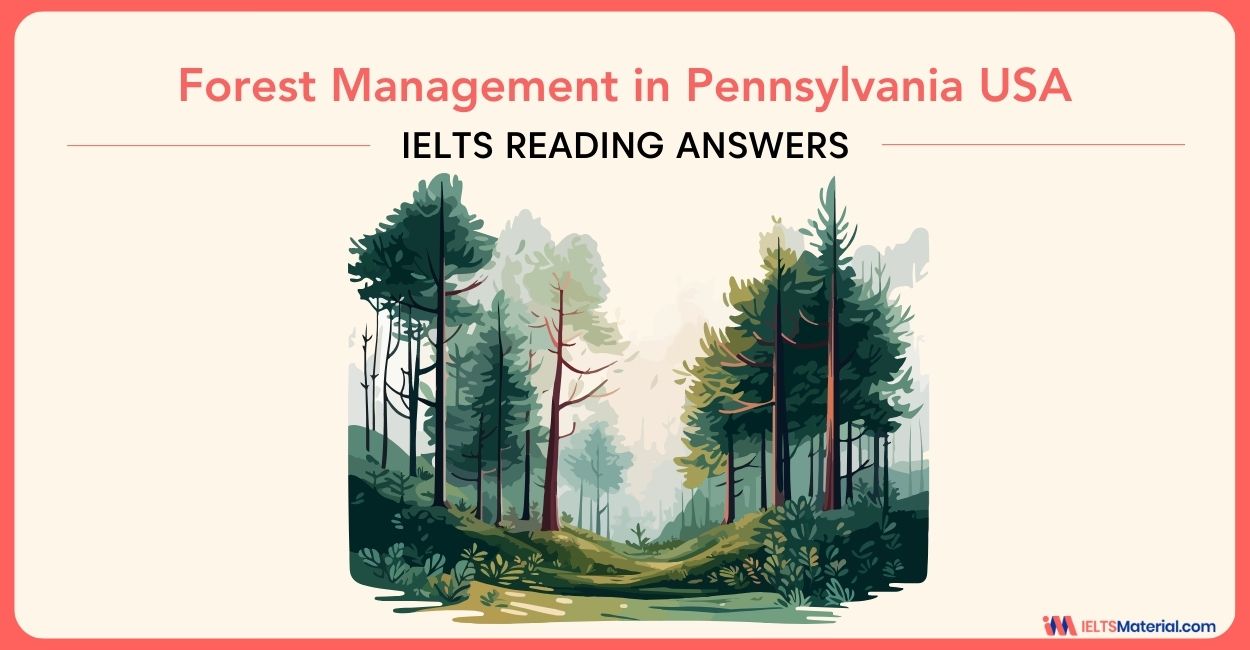Forest Management in Pennsylvania USA – IELTS Reading Answers
14 min read
Updated On
-
Copy link
Explore the strategies as well as the techniques to be used for the IELTS Reading passage on 'Forest Management in Pennsylvania USA' and dive into the answers to level up your preparation while aiming to achieve a band score of 8+.
Table of Contents

Limited-Time Offer : Access a FREE 10-Day IELTS Study Plan!
Forest Management in Pennsylvania USA is an Academic Reading passage which would help you to become familiar with the exam format. Therefore, it is ideal for you to try and solve the different question types mentioned. In this way, you will get an idea of the difficulty level of the passages in the actual reading test. This will enhance your skills and help you acquire a band 8+ in the IELTS Exam.
Since there are answers mentioned at the end, it is suggested to attempt the test with the timer on. As you dive into the answers, you will be able to get a clear picture of the areas which you need to improve. To ace in this section, you need to comprehend the information well and interpret it by skimming and scanning techniques. However, you need to practice diligently since the Academic passages are longer.
So, shall we move to the passage, 'Forest Management in Pennsylvania USA'? Let's start now!
Connect with our band 9 IELTS Trainers to crack your IELTS Reading in no time! Book a FREE Demo.
Types of Questions in Forest Management in Pennsylvania USA
It is crucial to practice different types of questions as you will encounter a combination of these in a passage. Therefore, you need to utilize the specific strategies to attempt them. There are 13 questions in total in the Reading Answers of Forest Management in Pennsylvania USA. Remember to comprehend the subject, identify important terms in the IELTS Academic Reading passages, and then respond in accordance with the instructions.
The question types found in this passage are:
- IELTS Reading Matching Information (Q. 1-5)
- IELTS Reading Matching Features (Q. 6-8)
- IELTS Reading Sentence Completion (Q. 9-13)
Tips to Solve Forest Management in Pennsylvania USA for a Band 8+
Since now you know the answers to the Forest Management in Pennsylvania USA Reading Answers with explanation, let us check out some quick IELTS Exam Preparation Tips for Band Score of 8+. As you prepare, it is vital to use these tips so that you can answer the three types of questions in the Reading Answers of Forest Management in Pennsylvania USA. Focus on the question type and then recall the tips which you can use as you solve the questions. Let's check them out:
- Do not just read the answers; instead, go through the questions and attempt them. Later, you can dive into the answers to check if you are able to comprehend the information and locate the information given in the question as well as the passage.
- Remember to put the stopwatch on so that you are aware of the time limits since Time Management for IELTS Reading is vital. This will make you get familiar with the exam conditions and enhance your reading skills.
- In the Matching Information question types, you will be given a list of statements for you to match. It is necessary to be aware of the main idea of each statement by reading the instructions, followed by the list of statements. This will also help you to figure out the keywords from each statement.
- However, in Matching Features type of questions, you need to read questions and underline or circle keywords. This will help you find out where you would have to read and find later. Also, focus on how often every detail or name is appearing in the passage.
- Understand How to Ace IELTS Reading with 'Keyword Technique' and then go through the text while trying to find out which paragraph or section contains the relevant information of the statements.
- Scan the passage and look for information given in the features and questions. You can also skim through the areas that are surrounded by keywords and features in the passage.
- Keep in mind that answers will not be in an an order as the questions most of the time. Therefore, do not get stuck while answering one question. You can move on to the next and come back to it later.
- Don’t get confused in case the text has synonyms of the information that is originally present in the question. Therefore, prepare with the IELTS Vocabulary so that your lexical resources could be enhanced.
- In the sentence completion, read the instructions carefully and focus on the word limit (no more than two, one word, etc) and important terms like ‘using words from the text’ or ‘from the text’. You have to follow these strictly.
- Read the incomplete sentences first and then locate where the information is by scanning quickly.
- Also, check your spelling and remember that your answer should be grammatically correct. Your answers will not be considered if they are grammatically wrong or the spelling is not correct.
Want to learn how to answer Matching Information questions? Look at the video below!
Reading Passage - Forest Management in Pennsylvania USA
Forest Management in Pennsylvania USA
How managing low-quality wood (also known as low-use wood) for bioenergy can encourage sustainable forest management
A A tree’s ‘value’ depends on several factors including its species, size, form, condition, quality, function, and accessibility, and depends on the management goals for a given forest. The same tree can be valued very differently by each person who looks at it. A large, straight black cherry tree has high value as timber to be cut into logs or made into furniture, but for a landowner more interested in wildlife habitat, the real value of that stem (or trunk) may be the food it provides to animals. Likewise, if the tree suffers from black knot disease, its value for timber decreases, but to a woodworker interested in making bowls, it brings an opportunity for a unique and beautiful piece of art.
B In the past, Pennsylvania landowners were solely interested in the value of their trees as high-quality timber. The norm was to remove the stems of highest quality and leave behind poorly formed trees that were not as well suited to the site where they grew. This practice, called ‘high-grading’, has left a legacy of ‘low-use wood’ in the forests. Some people even call these ‘junk trees’, and they are abundant in Pennsylvania. These trees have lower economic value for traditional timber markets, compete for growth with higher-value trees, shade out desirable regeneration and decrease the health of a stand leaving it more vulnerable to poor weather and disease. Management that specifically targets low-use wood can help landowners manage these forest health issues, and wood energy markets help promote this.
C Wood energy markets can accept less expensive wood material of lower quality than would be suitable for traditional timber markets. Most wood used for energy in Pennsylvania is used to produce heat or electricity through combustion. Many schools and hospitals use wood boiler systems to heat and power their facilities, many homes are primarily heated with wood, and some coal plants incorporate wood into their coal streams to produce electricity. Wood can also be gasified for electrical generation and can even be made into liquid fuels like ethanol and gasoline for lorries and cars. All these products are made primarily from low-use wood. Several tree- and plant-cutting approaches, which could greatly improve the long-term quality of a forest, focus strongly or solely on the use of wood for those markets.
D One such approach is called a Timber Stand Improvement (TSI) Cut. In a TSI Cut, really poor-quality tree and plant material is cut down to allow more space, light, and other resources to the highest-valued stems that remain. Removing invasive plants might be another primary goal of a TSI Cut. The stems that are left behind might then grow in size and develop more foliage and larger crowns or tops that produce more coverage for wildlife; they have a better chance to regenerate in a less crowded environment. TSI Cuts can be tailored to one farmer’s specific management goals for his or her land.
E Another approach that might yield a high amount of low-use wood is a Salvage Cut. With the many pests and pathogens visiting forests including hemlock wooly adelgid, Asian longhorned beetle, emerald ash borer, and gypsy moth, to name just a few, it is important to remember that those working in the forests can help ease these issues through cutting procedures. These types of cut reduce the number of sick trees and seek to manage the future spread of a pest problem. They leave vigorous trees that have stayed healthy enough to survive the outbreak.
F A Shelterwood Cut, which only takes place in a mature forest that has already been thinned several times, involves removing all the mature trees when other seedlings have become established. This then allows the forester to decide which tree species are regenerated. It leaves a young forest where all trees are at a similar point in their growth. It can also be used to develop a two-tier forest so that there are two harvests and the money that comes in is spread out over a decade or more.
G Thinnings and dense and dead wood removal for fire prevention also center on the production of low-use wood. However, it is important to remember that some retention of what many would classify as low-use wood is very important. The tops of trees that have been cut down should be left on the site so that their nutrients cycle back into the soil. In addition, trees with many cavities are extremely important habitats for insect predators like woodpeckers, bats and small mammals. They help control problem insects and increase the health and resilience of the forest. It is also important to remember that not all small trees are low-use. For example, many species like hawthorn provide food for wildlife. Finally, rare species of trees in a forest should also stay behind as they add to its structural diversity.
—–
*Stand – An area covered with trees that have common features (e.g. size)
Questions 1-5
The Reading Passage has seven paragraphs, A-G.
Which paragraph contains the following information?
Write the correct letter, A-G, in boxes 1-5 on your answer sheet.
NB You may use any letter more than once.
1 bad outcomes for a forest when people focus only on its financial reward
2 reference to the aspects of any tree that contribute to its worth
3 mention of the potential use of wood to help run vehicles
4 examples of insects that attack trees
5 an alternative name for trees that produce low-use wood
Questions 6-8
Look at the following purposes (Questions 6-8) and the list of timber cuts below.
Match each purpose with the correct timber cut, A, B or C.
Write the correct letter, A, B or C, in boxes 6-8 on your answer sheet.
NB You may use any letter more than once.
6 to remove trees that are diseased
7 to generate income across a number of years
8 to create a forest whose trees are close in age
List of Timber Cuts
A a TSI Cut
B a Salvage Cut
C a Shelterwood Cut
Questions 9-13
Complete the sentences below.
Choose ONE WORD ONLY from the passage for each answer.
Write your answers in boxes 9-13 on your answer sheet.
9 Some dead wood is removed to avoid the possibility of ………………. .
10 The ………………. from the tops of cut trees can help improve soil quality.
11 Some damaged trees should be left, as their ………………. provide habitats for a range of creatures.
12 Some trees that are small, such as ………………., are a source of food for animals and insects.
13 Any trees that are ………………. should be left to grow, as they add to the variety of species in the forest.
Looking for premium reading material to practice reading passages like ‘Forest Management in Pennsylvania USA’?Check out the IELTS Reading (Academic) Test Guide: Essential Tips, Strategies, and Practice Tests” (April-June 2025)!
Answers with Location and Explanations for Forest Management in Pennsylvania USA
Did you nail the test? Let’s now review the answers to the questions from the passage in the reading section, Forest Management in Pennsylvania USA, and assess your improvement for a higher IELTS Reading Band Score. Remember to note the areas of improvement so that you can strengthen it and level up your preparation.
| Answer | Question Type | Answer Location | Answer Explanation |
| 1. B | Matching Information | Paragraph B | The selected paragraph reveals, “In the past, Pennsylvania landowners were solely interested in the value of their trees as high-quality timber…This practice, called ‘high-grading’, has left a legacy of ‘low-use wood’ in the forests. Some people even call these ‘junk trees’, and they are abundant in Pennsylvania.”. This tells us that the second paragraph informs us about how focus on financial awards (high-quality timber) has resulted in a bad outcome for the forest in Pennsylvania where cutting of the high grade timber had led to a forest of low-quality timber or junk trees only. Hence, the answer is B. |
| 2. A | Matching Information | Paragraph A, Line 3 | In the quoted line of Paragraph A, it is declared, “A large, straight black cherry tree has high value as timber to be cut into logs or made into furniture…the real value of that stem (or trunk) may be the food it provides to animals.”. This points to the fact that the first paragraph discusses the aspects of any tree that contribute to its worth. Hence, the answer is A. |
| 3. C | Matching Information | Paragraph C, Line 4 | In the highlighted line of Paragraph C, it is reported that “Wood can also be gasified for electrical generation and can even be made into liquid fuels like ethanol and gasoline for lorries and cars.”. This proves the fact that the third paragraph specifies the use of wood to run vehicles. Hence, the answer is C. |
| 4. E | Matching Information | Paragraph E, Line 2 | In the quoted line of Paragraph E, it is said that “With the many pests and pathogens visiting forests including hemlock wooly adelgid, Asian longhorned beetle, emerald ash borer, and gypsy moth, to name just a few, it is important to remember that those working in the forests can help ease these issues through cutting procedures.”. It is clear from the above-mentioned line that the fifth paragraph mentions the different types of insects that attack trees. Hence, the answer is E. |
| 5. B | Matching Information | Paragraph B, Line 3–Line 4 | In the specified lines of Paragraph B, it is communicated that “This practice, called ‘high-grading’, has left a legacy of ‘low-use wood’ in the forests. Some people even call these ‘junk trees’…”. In this way, it is shown that the alternative name for trees that produce low-quality is junk trees. Hence, the answer is B. |
| 6. B | Matching Features | Paragraph E, Line 1 & Line 3 | The mentioned lines of Paragraph E say that “Another approach that might yield a high amount of low-use wood is a Salvage Cut…These types of cut reduce the number of sick trees and seek to manage the future spread of a pest problem.”. These lines point out that the Salvage Cut is mainly used to remove trees that are diseased (sick). Hence, the answer is B (a Salvage Cut). |
| 7. C | Matching Features | Paragraph F, Line 4 | The given line of Paragraph F describes, “It can also be used to develop a two-tier forest so that there are two harvests and the money that comes in is spread out over a decade or more.”. It is clear that the Shelterwood Cut is used to create a two-tier forest that will have two harvests and generate income across a number of years (a decade or more). Hence, the answer is C (a Shelterwood Cut). |
Unlock Remaining Explanations
| 8. C | Matching Features | Paragraph F, Line 3 | In the above-mentioned line of Paragraph F, it is given, “It leaves a young forest where all trees are at a similar point in their growth.”. This shows that the Shelterwood Cut is used to remove mature trees and leave behind a forest of young trees that are close in age (at a similar point in their growth). Hence, the answer is C (a Shelterwood Cut). |
| 9. fire | Sentence Completion | Paragraph G, Line 1 | The given line of Paragraph G states, “Thinnings and dense and dead wood removal for fire prevention also center on the production of low-use wood.”. From the quoted line, it is clear that dead woods are removed to prevent fire. Hence, the answer is ‘fire’. |
| 10. nutrients | Sentence Completion | Paragraph G, Line 3 | The following line of the concluding paragraph mentions, “The tops of trees that have been cut down should be left on the site so that their nutrients cycle back into the soil.”. This clears the fact that the nutrients from the top of the trees are left behind to improve solid quality. Hence, the answer is ‘nutrients’. |
| 11. cavities | Sentence Completion | Paragraph G, Line 4 | This line of Paragraph G affirms that “In addition, trees with many cavities are extremely important habitats for insect predators like woodpeckers, bats and small mammals.”. It can be concluded that some damaged trees should be left, as their cavities provide habitats for a range of creatures. Hence, the answer is ‘cavities’. |
| 12. hawthorn | Sentence Completion | Paragraph G, Line 7 | This suggested line of Paragraph G points out that “For example, many species like hawthorn provide food for wildlife.”. In light of the fact that some trees that are small, such as hawthorn, are a source of food for animals and insects, the answer is ‘hawthorn’. |
| 13. rare | Sentence Completion | Paragraph G, Line 8 | The referred line of Paragraph G says, “Finally, rare species of trees in a forest should also stay behind as they add to its structural diversity.”. Based on the reference, we can conclude that rare trees should be left to grow, as they add to the variety of species (structural diversity) in the forest. Hence, the answer is ‘rare’. |
Enroll into our Free IELTS Webinar and learn more about techniques to improve your reading speed.
With the right strategy, you will be able to enhance your reading skills by understanding skimming and scanning techniques. Remember to practice on a regular basis so that you are quite accustomed with the exam format. This will build your confidence and help you towards achieving your desired band scores. So, don't just stop here! Continue with the flow and explore more topics so that you can attempt the questions easily.
Check More Reading Passages
Also Check :
Practice IELTS Reading based on question types

Start Preparing for IELTS: Get Your 10-Day Study Plan Today!
Explore other Reading Practice Tests

Nehasri Ravishenbagam

Nehasri Ravishenbagam

Kasturika Samanta

Kasturika Samanta
Recent Articles

Nehasri Ravishenbagam

Haniya Yashfeen

Haniya Yashfeen

Haniya Yashfeen




Post your Comments